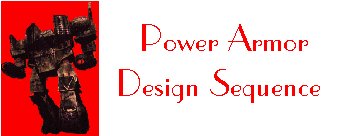
I: The first consideration is always the mission: What is it? The equipment, armament, and protection on a stealthy scout is not going to match that of a heavy fire-support platform, so be sure to take that into consideration when designing the suit.
II: The next step is the selection of the Layout. The Layout is the basic frame of the power armor unit. It's not always universal in size, shape, number of limbs, etc. - it's just the basic system of the servos, pneumatics, hydraulics, and synthetic musculature to be layed down within. The Layout types can be selected from the Layout inventory page. Once a Layout has been selected, write down the class, weight, cost, S.R. per location, strength and carrying/lifting capacity down.
III: Using the Layout's base physical strength, calculate the base M.D.C. of the power armor using the following formula;
Head- P.S.# x 2.5
Arms- P.S.# x 2.5
Legs- P.S.# x 5
Main Body- P.S.# x 7.5
IIIB: S-Mart does manufacture laser refractive chrome armor, they call mercduranium, and does make it available for custom power armor types. To calculate these figures multiply the base M.D.C. in step III, by three, multiply the layout cost by ten, double the layout weight, and reduce the base speed by 25%.
IV: If the power armor's mission warrants it, you may select additional armored protection now. Record the M.D.C. for the head, arms, legs, and main body - and then add it to the base M.D.C. determined in step III. This is the final M.D.C. of the power armor.
V: Under the Layout Size section, a list of factors, abbreviated S.R., were recorded. The S.R. is "System Requirements", basically a measurement of the number of systems that the suit can accomodate. Each system added to the suit will take up a certain number of this S.R. rating. While referring to systems contained inside of the suit, each suit can accomodate an equal number of systems OUTSIDE of the suit. This means that a seven foot tall suit with 20 S.R. available in the head area, can also accomodate 20 S.R. worth of systems outside of the helmet in the form of sensors, communications arrays, and even weapons. Now, returning to step I and considering the mission of the prospective power armor suit, go to the power armor systems page and select the systems necessary to complete the mission intended. Do not forget to select at the very least an interface system, a control system, and a power system as these are necessary components for power armor operations. Note that systems that are installed internally are protected by any additional armor purchased for the suit.
VI: Total all the costs of the systems, including layout, armor, and all suit systems. Now, the tricky part. The number of suits to be produced on this order will effect the final price dramatically. For one to five suits multiply this number by 2.25 to determine the final cost of each suit. For six to twenty suits multiply the number by 2 to determine the final cost. For twenty-one to fifty suits multiply the number by 1.5 to determine the final cost. For fifty-one suits and above - round up to the nearest 100,000, and this is the final cost. These figures factor in costs of tooling, manufacturing, and fitting these specially produced custom suits of power armor. Upon completion of these final figures you are brought to the final cost of your' custom suit of power armor. Keep in mind that though S-Mart produces these Power Armor units, that does not mean they keep the expected confidentiality one would find in pre-cataclysm times, as they immediately report the radar signature, statistics, speed capabilities, armor strength and weaponry carried on board any custom unit they produce, directly to the N.O.M.A.D.s, to be added to combat computers throughout the Alliance.
Questions?|S-Mart|SirTenzan's RIFTS Gallery
